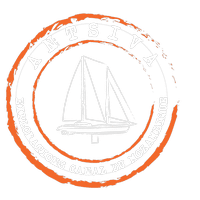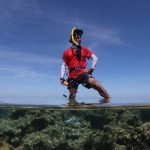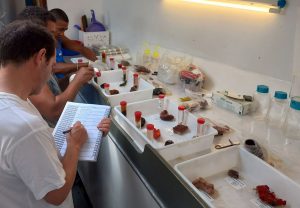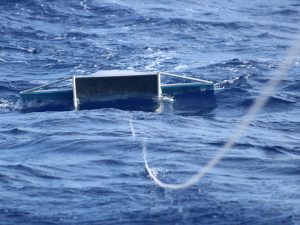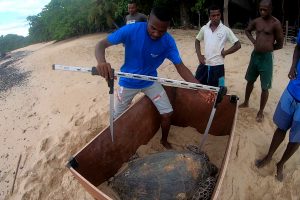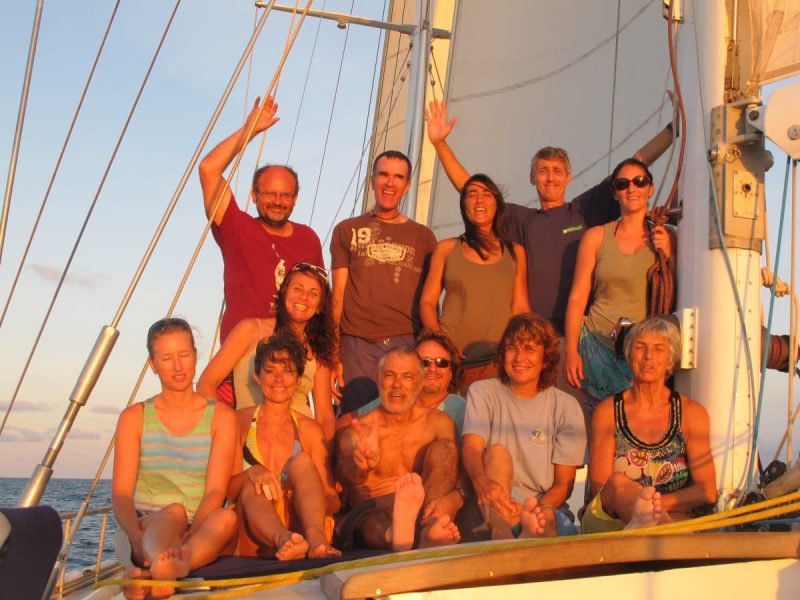
Thursday December 5th
It is in the brown waters of the port of Majunga that Antsiva awaits the team of scientists.
Boarding is scheduled for the high tide of 16h, via a small dilapidated pontoon which only holds by a miracle. But we are in Madagascar and despite the deplorable state of port facilities, the good mood is still present!
With the help of Jeff and Sebastien, our two new sailors shock, the mountain of luggage takes place on board. Then it is the turn of the scientists to embark.
The team is composed of the same participants, except two new ones: Corinne who replaces Martine for diving safety and assists Lionel on the corals and Serge, the new "little" who has not yet made his mark aboard Antsiva and is responsible for mapping reef habitats.
The reunion is noisy and warm. This is the beginning of a new mission and the very first hours are always marked by a great relief mixed with a certain excitement shared by all.
But, the scientists' working time is precious and the first objective is to reach Juan de Nova as soon as possible. So let's get off the anchor as soon as the team gets on board, everyone finding their cabin and their habits.
Friday, December 6
Navigation is carried out quietly with the engine.
A particularly Zen navigation allowing reading, rest, chatter and briefings or work on a computer.
These two days of crossing are also for scientists a way to take stock, a parenthesis in time, a moment of decompression where they let go of the daily problems and devote themselves to the final preparations for the mission.
Saturday, December 7th
7 am, arrival at the anchorage of Juan de Nova. We immediately contact the military to signal our presence and possibly ask them for help in transporting equipment. No luck, it is the relief on the island and the new contingent is expected in the morning. They therefore have little time to devote to scientists. However, they manage to free themselves before the arrival of the Transal and the baggage of the team on land are transferred by tractor to the old gendarmerie.
Meanwhile, Serge and Lionel are already at work and carry out a first mapping station not far from the anchorage.
At the end of the morning, Sebastien the cameraman journalist, left on the island during the previous rotation, joins us and the whole team is gathered for a lunch aboard Antsiva.
In the afternoon, a first dive Biodiversity is scheduled while the shore team composed of Joseph, Nicky, Maya and Lydiane arrives to install their laboratory. The former gendarmerie located north of the island will indeed constitute their camp of life and work throughout the duration of the mission. This base offers large premises rather comfortable but has the disadvantage of being away from the barracks, which involves frequent trips back and forth at meal times.
Tonight, a big welcome drink is planned for the military. Pascale goes with a part of the team.
In the evening, the wind rises quite strong. The night promises to be well ventilated!
Sunday, December 8
In the morning, the wind is still blowing and the sea has widened making the dive impossible. In order not to waste time, Plume, Lionel and Serge perform an apnea mapping station.
After lunch, as the weather conditions did not improve, the divers joined the team ashore to work on the flat at low tide.
Meanwhile, in order to improve the working conditions of the shore crew, we go down two kayaks and a freezer. Kayaks will allow scientists to move faster on the flat because in Juan de Nova, the distances are large and the steps with water at mid-thigh under a blazing sun are sometimes trying. The freezer landed from Antsiva and installed in the former gendarmerie will supply ice breads necessary for the conservation of the samples.
Monday, December 9
The wind has weakened and a first dive is planned for the boat with Hélène, Serge and Thierry. Program, habitat description and GCRMN (Global Coral Reef Monitoring Network).
In the afternoon, the team leaves for a diving Biodiversity in the west but a strong current makes the work difficult.
Tuesday, December 10
Hélène and Serge are fans of morning dives. Serge as "habitologist" must indeed perform a maximum of mapping stations to obtain a description of the most accurate and detailed habitats possible.
Around 8 am, Lydiane and Chloe join us. As in other years, they divide their time between collecting diving samples and working on the shore. So, every morning, they board Antsiva. Today, Sébastien accompanies them. He will follow the divers and shoot underwater images of their work.
We weigh anchor and depart for the north drop. On Juan de Nova the dive stations are all distant and located at least 5 miles from the anchorage. So we must move Antsiva near the station and then launch from the annexes.
Two dives next to the boat:
the first "Biodiversity and Cartography",
the second GCRMN.
We return to the anchorage at night and Chloe, Lydiane and Sebastien arrive to find the team on the ground.
Wednesday 11 December
Today, we have the pleasant surprise of waking up on a sea of oil, without a breath of air. Ideal conditions to explore the great South, this part of the island is difficult to access because always beaten by the winds.
After the morning dive of Serge and Hélène, the girls join us on board and we leave the anchorage to reach the first station around 10am. Antsiva remains adrift while the two appendages approach breakers to ensure the safety surface of the divers. Nearby, on the reef, where the proud charcoal wreck still stands, the waves unfurl their long turquoise train, which then collapses into a bubbling sparkling foam.
Two successive dives are made and we leave the area to reach the anchorage before dark.
Tonight, Juan releases a serenity and a contagious calm and we do not tire of admiring the sun disappear on this blazing horizon.
It's already dark when we drop the girls. The night may be a little short for our two brave!
Thursday 12 and Friday 13 December
We always enjoy exceptional weather conditions that allow us during these two days to explore the northwestern and southwestern corners of the island.
At each station, scientists achieve their three-fold objective: Biodiversity, Habitat Description and GCRMN.
Saturday December 14th
Decidedly, the good star who watches over the two mats of Antsiva works miracles. It's getting more and more beautiful. The sea is becoming flatter. The sky is becoming brighter and the water more and more clear ...
Today we will explore the western tip of the island. Antsiva at anchor is weightless on a crystal clear water with two annexes nearby ensuring the safety surface.
Scientists come back from their dive with a smile on their faces. These two dives are magnificent offering an abundance of incredible fish and a great diversity of life. And always the ubiquitous sharks (a constant of all the dives on Juan de Nova) that evolve around the divers, accompanying them even during their decompression stop.
Sunday, December 15
Always great weather and always a sea of oil. Antsiva as every morning leaves his anchorage and we leave for an exploration of the eastern slope. After a first dive, we get closer to the East Point. While Antsiva remains drifting, the two annexes accompany the divers on the reef where a beautiful wreck rests. Again, the diving is beautiful and very rich.
In the evening, the gendarme and the two officers of the contingent are invited to have a drink on board. At the time of the escort, it is night and the tide is already very low. Jeff manages to drop them on the ground in annex but can not go back in the opposite direction. After many unsuccessful attempts, he must face the facts, there is not enough water, he is stuck on his schedule waiting in the dark rising tide ...
We are asking for help from the soldiers who, very kindly, go up the annex on the beach and offer him the cover. Jeff continues his evening at the gendarmerie with the shore team who welcomes him with open arms. Rum, chicks and chocolate ... it does not take more to make a sailor happy!
Monday, December 16th
Today, it is expected that some of the divers will join the team ashore to perform stations on the flat.
Early in the morning to enjoy the tide, Serge, Thierry and Patrick leave with the white annex and go retroiuver Joseph, Nicky and Maya who wait for them at the gendarmerie.
The annex and the kayaks leave to explore the immense flat which is discovered completely at low tide.
The tidal range is important and the flat is so large that the boats are forced to run aground and wait for the rising tide on the reef to dry during the hottest hours of the day. When our divers come on board Antsiva, they are satisfied with their day's work but are quite burned by the sun.
Tuesday, December 17th
Last day of mission. All the last dives before the big storage.
The white annex is put back on board as well as the kayaks and the freezer. On the ground, scientists are working to close the trunks that will leave the Transal and tidy the material that embarks aboard Antsiva.
Finally, at 4 pm, everyone is on board and everything is stalled. We weigh anchor one last time and it is on a sea as beautiful as we leave Juan de Nova. Juan and his white beaches, his filao trees and his millions of terns. Juan and his water with changing colors. Juan and his shipwrecks, his sharks and his manta rays.
A last stroke of trumpet to salute the military and we will soon have, in our wake phosphorescent, a tiny red dot that shines in the distance: the small lighthouse, which for the "airmen, sailors, ships and caravels, all the nights in Juan spark ... "
Thus ends the last part of this mission BioReCie (Biodiversity - Resources and Conservation of coral reefs scattered islands).
We have been following this scientific and human adventure for 3 years and we are happy to have contributed to its success and the achievement of its objectives.
A big thank you to you all for these 3 years of sharing and exchange where everyone has been able to integrate us in the team and take the patience and time to introduce us to his research work.
And finally, a huge thank you to you Plume for giving us your trust throughout this adventure.
